Table of Contents
Mystery Snail Overview
A mystery snail is a wonderful addition to almost any aquarium. This is partly because they do a great job of helping clean the tank and because they are easy to care for and don’t require a lot of difficulty or regular maintenance.
These snails are very popular, but understanding how to take care of them, what type of environment they need, and how to keep them happy and healthy is very important before adding a mystery snail to your aquarium.
These small gastropods are a fair addition to any community tank, provided you know the basic processes involved in taking care of them. This guide should give you an insight into everything there is to know about mystery snails and the work that goes into taking care of them.
| Information Chart | Mystery Snails |
| Scientific Name | Pomacea bridgesii |
| Family | Ampullariidae |
| Care Level | Easy to Intermediate |
| Temperament | Peaceful |
| Color | Brown, Black, Ivory, Gold |
| Lifespan | 1 year |
| Size | Up to 2mm in diameter |
| Diet | Vegetarian |
| Minimum Tank Size | 5-10 gallon |
| Temperature | 68°F-84°F |
| Water Conditions | Freshwater, alkaline |
| Tank Mate Compatibility | Peaceful, same species, freshwater creatures |
Mystery Snail Appearance
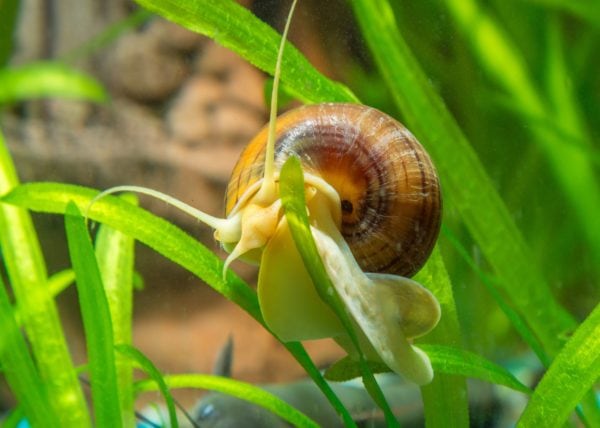
As you will soon discover, mystery snails are available in different types and colors. This is what distinguishes them from the staple nerite snails that several aquarists know of. Depending on your choice, you can easily add a pop of color to the tank.
Besides the staple brown, black, ivory, and gold variants, they come in different species too. The Albino mystery snail is one of the most common examples of that. They have a paler color and appearance with gold or brown stripes on their bodies.
Even advanced aquarists tend to get confused with the availability of options. They are available in a wide range of colors, patterns, and appearances. Compared to the other standard tank snails, they are quite small in size. However, the bright pop of color makes them distinguishable from the rest.
In mystery snails, their apex is positioned slighting curved towards the aperture, making them unique in their skin. They have four whorls present in their body as they mature and become an adult. The snail also has two additional tentacles under their food besides the siphon that helps with feeding.
Another important factor to their unique appearance is the operculum. If you aren’t aware, this plate-like structure closes the shell’s opening in the mystery snails. One of the easiest ways to detect the health of a snail is to check its operculum. If the operculum falls off, it means the snail is dead.
As for the appearance of their head, the mystery snails sport two large tentacles on the top of their head. Besides contributing to their anatomy, these work as sensory organs. They help detect danger and even food sources around them. Their eyes are responsible for movement and keeping a check on the light sources around.
The moment the mystery snail detects a predator around them, or any kind of danger, for that matter, it forces itself to safety. The operculum shuts off, closing the shell and protecting the organism until it’s safe.
Different Types of Mystery Snails
One of the coolest features of mystery snails is that they come in a wide variety of colors and appearances, which means that aquarium owners can easily choose a snail that will add a touch of color to their freshwater tank.
The shells are available in brown, black, ivory, and even gold variants. These are attractive neutral colors that won’t cause the snails to really stick out in the water but do add a touch of interest to the tank.
Lifespan of Mystery Snails
The typical lifespan of a mystery snail is up to a year. Although it does sound less compared to the care the snails need, this is typical for any tank snail.
Unlike other aquatic species, like fishes, you can’t prolong the lifespan of a mystery snail. However, inadequate care can end up shortening their life. It is on very rare occasions that you’d find a mystery snail living for more than a year.
Mystery Snail Size
The average size of an adult and completely mature mystery snail is up to 2 inches in diameter. The reason why they are typically measured in diameter is because of their round-like appearance.
In cases with poor living conditions in captivity, a mystery snail can grow up to 1 inch in diameter and then seize growing. If you find your snail in the community tank not growing up to its optimal size, it indicates poor living conditions.
Natural Habitat and Origin
Scientifically named Pomacea bridgesii, the mystery snails belong to the Class Gastropoda. Besides being called mystery snails, they are also often termed apple snails.
These are freshwater snails that are typically found in South America. They are found in abundance in countries like Brazil, Bolivia, and Peru.
Since they are vegetarian, you will often find these small organisms scavenging throughout the tank, searching for plant matters. They are found in different water bodies, including swamps, rivers, and even ponds.
In captivity, the mystery snails tend to stick to the bottom of the tank, near the substrate. This is because they are bottom feeders and eat whatever they can find at the bottom.
One unique and distinguishing feature of the mystery snails is their complex eyes. They are found over the cephalic eyestalk and are responsible for scoping the surroundings. They can also regrow in a few weeks in case they are damaged or injured.
Mystery Snails Tank Setup and Care
Understanding how to take care of a mystery snail is important before adding them to a tank so that there isn’t any problem with them dying or not thriving in the conditions.
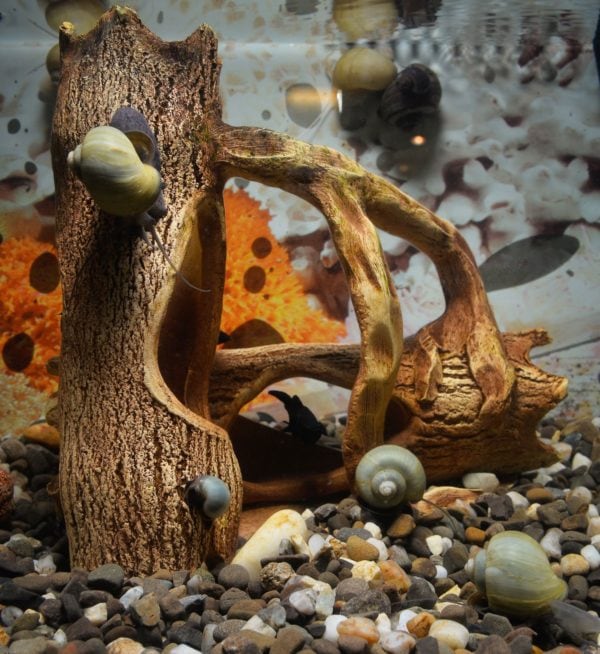
They spend most of their time on the bottom of the tank grazing on food, and their only fear is a predator that could break through their shell. Knowing this, tank owners can easily set up their tanks to be habitable places for these snails.
Mystery Snails Tank Size and Specifications
These snails love a lot of vegetation in the tank so that they have plenty of food to eat. If there isn’t enough food in the tank, they will leave the water, which is why providing a lot of food is important, as is keeping a tight lid on the tank.
While having a lot of vegetation on the bottom of the tank is important so that the snails can eat, they still need sand, pebbles, or gravel on the bottom so that they can easily move around. The type of substrate used in a tank doesn’t matter as long as the snail can move easily.
Optimum Tank Size for Mystery Snails
They don’t get much bigger than around 2” in diameter, making them great for including in larger and smaller tanks. Even as adults, they only have around four whorls, and they are all relatively small, which makes them great tank mates in most conditions.
Mystery snails aren’t very picky about their tanks. They can make do and acclimatize themselves to their surroundings easily.
However, if you consider keeping them in a community tank, start with a 5-10 gallon tank. If you are keeping a smaller tank like these, ensure that you don’t overcrowd them. Keeping 1-2 snails per 5-10 gallons is ideal.
Filter Type
When it comes to filters in a community tank for mystery snails, they aren’t typically wary of it. If your tank houses aquatic species that don’t require a filter, you can skip them.
However, we’d recommend installing a slow-speed or less power filter like Sponge filters to keep the water clean and moving. This will reduce the waste and keep the organisms in the best of their health inside the tank.
Substrate
As mentioned before, mystery snails are bottom feeders, which means that having the correct substrate in the tank is key. While you’d think that keeping finer substrate like fine sand will be ideal, it is quite the complete opposite of that.
Mystery or Apple Snails need a good resistance on the bottom of the tank for easier movement. Finer substrates make it difficult for them to move around the bottom of the tank. Instead, you can fill it up with gravels, pebbles, and a mix of sand. This makes it a lot easier for them to move around in the tank without hurting them.
However, one factor worth considering is the size of the gravels and pebbles. Avoid putting something bigger than the snail.
Water Parameters for Mystery Snail
Even though these snails are very hardy, they don’t like many rapid changes in their water. This means that changing the water needs to be done carefully and correctly so that the snails aren’t accidentally shocked. They prefer to live in highly oxygenated waters that have a lot of movement.
Water Temperature
The ideal water temperature for mystery snails in a community tank is 68°F-84°F. This indicates that they don’t enjoy extremely warm temperatures, so ensure that you keep a check on that.
pH Level
The perfect water pH level for mystery snails is 7.6-8.4. You can see from the levels that they prefer staying in alkaline water conditions with relatively high pH.
The reason why the water needs to be alkaline is due to their shells. Any kind of low pH can lead to the acidic nature of the water, which can cause their shells to dissolve. The calcium carbonate in their shells reacts with the acid in the water and dissolves it.
This is why you must keep a close eye on their shells. If you find any kinds of cracks, pits, or thinning, it is a sign of low pH in the water.
Water Hardness
The typical water hardness level for mystery snails is between kH 12-18.
Mystery Snails Tank Landscape
When setting up the tank for mystery snails, there’s only one point of emphasis –PLANTS.
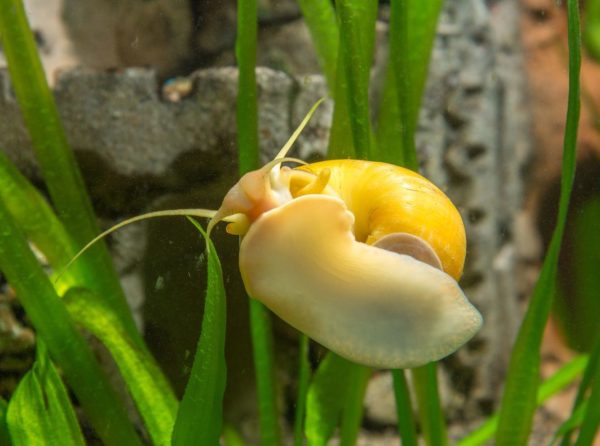
Yes, that’s all. Even if you don’t add anything else to the tank, your snails will do with the available plants.
Since they are always scoping for plant matters in the tank, vegetation is crucial. As for what types, you can stick to smaller floating aquatic plants.
Plants like java moss, hornwort, and anubias make for good additions. Another tip is to add tougher and hardy plants that your snails can munch on.
Besides plants, big chunks of rock also make a great addition. They ensure optimal growth of algae on them that feeds the snails now and then. However, don’t add too many. One or two pieces of big rocks make up for the needs. Also, avoid putting rocks with jagged and rough ends since those can injure the shells.
Feeding Mystery Snails
Mystery snails love eating on rotting or dead plants, and they will even graze on any algae growing along the bottom or on the sides of the tank.
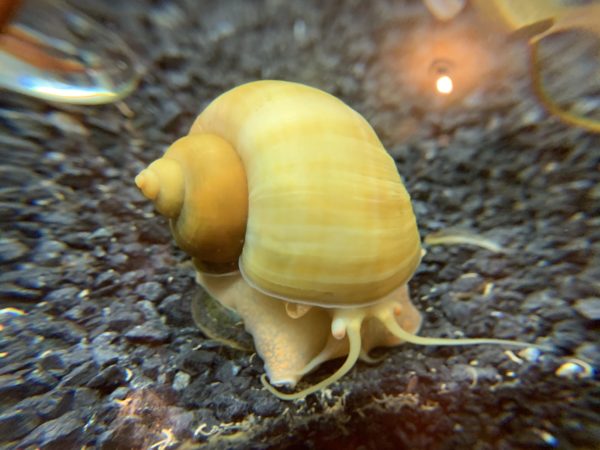
Since they graze so easily and eat such a wide variety of foods, they are generally easy to care for as long as enough vegetation is provided in the tank for them to eat.
Having a lot of vegetation in the tank is a great way to feed them naturally, as the snails will eat any rotting or dead parts of the plant, which also helps keep the tank clean and looking great. Aquarium owners who haven’t established many plants in their tank will need to add food for their snails.
Washing and blanching vegetables or leafy greens and adding them to the tank is a great way to feed these snails. However, it is important to remove uneaten food after a while so that it doesn’t lower water quality.
Naturally-occurring algae on the rocks in the tank serve as the foundation of their diet. However, the formation of natural algae takes time, so you need to supplement from time to time. There are algae sinking pellets that make for a great addition to their diet.
Besides those, you can feed them a range of leafy greens and vegetables, including kale, zucchini, cucumber, and even spinach.
However, keep in mind that “less is more.” If the tank is overfilled with vegetation and algae, it can affect the snails negatively. So, try to limit it to the amount they will be able to eat and munch on.
Some aquarists even throw in a few calcium supplements every few weeks to help maintain the integrity of the snail’s shell.
If you are concerned about the frequency, avoid overfeeding them. Try to limit the pellets or veggies once or twice a day because the snails will munch on the plants throughout the day regardless.
Mystery Snails Behavior and Temperament
If you aren’t a big fan of chaos, these little creatures are just what you need. They are peaceful, non-territorial, and like to keep to themselves.
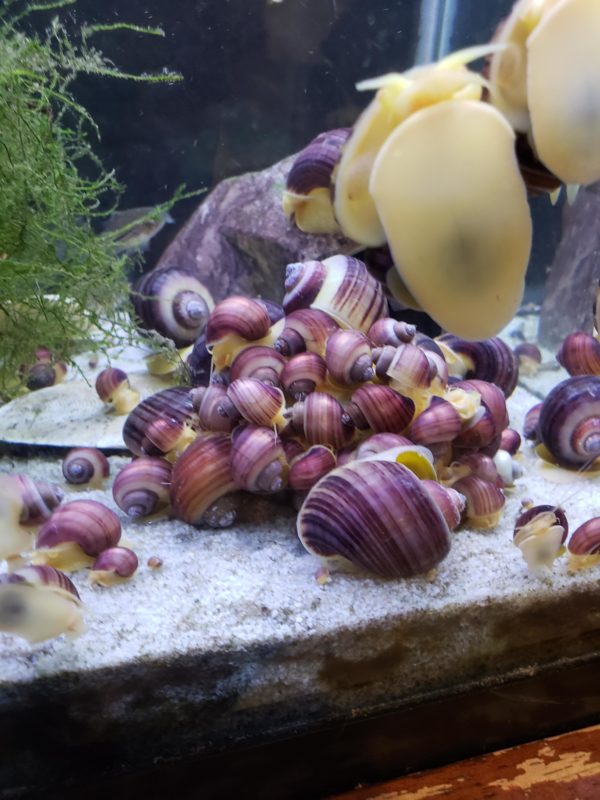
They don’t like to get into fights or what other creatures in the tank are doing. They like to keep doing what they find interest in, which is looking for food, for the most part.
However, if they feel threatened in their surroundings, they will close down and get inside the shell to avoid getting hurt. Also, despite their small size, they are quick and active. You won’t find them straying idly for long. They like to move around in the tank, especially around the bottom.
If you notice your mystery snail floating on the water, it is a lot more common than you imagine. However, you need to keep an eye out. If they prolong floating for a long time, it is a sign of disease or impending death.
Breeding Mystery Snails
Male and female mystery snails will mate without any help as long as the tank conditions are correct. When the female is going to lay her eggs, she will place them at the water’s surface in a small cocoon. The eggs will hatch in about a month.
Removing the cocoon is the easiest way to prevent more snails from being born if the tank isn’t large enough to support babies.
To encourage breeding, make sure that there is a headspace above the water level so that the mother can put her eggs there. Also, make sure to provide plenty of food, as the snails won’t mate when there isn’t enough food to feed their babies.
Once they are ready, the eggs hatch and little babies come out of them. Unlike the other fishes and fries, the snails are quite independent. They can tend to themselves just fine, so you don’t have to fret once they are born.
Mystery Snails Common Diseases and Treatment
Even though mystery snails are quite hardy and aren’t generally plagued with diseases, you need to be vigilant.
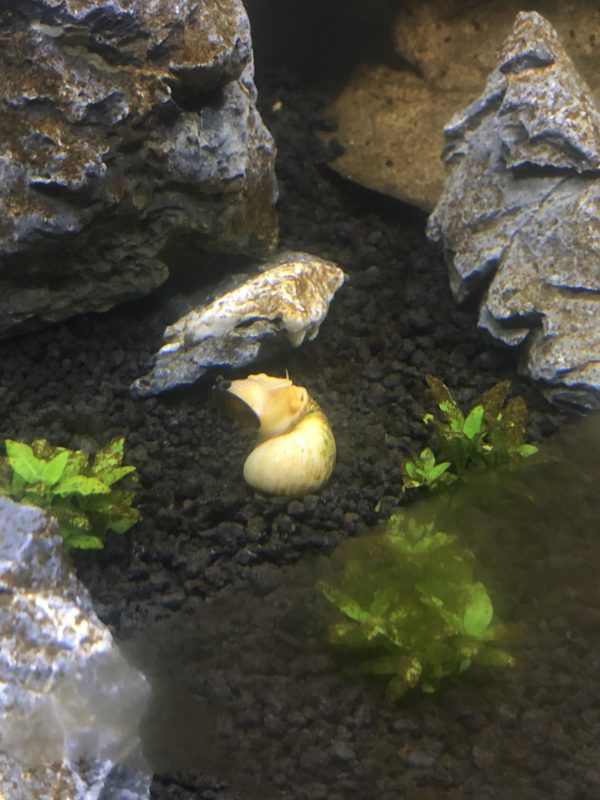
Any kind of drastic change to the water conditions can result in diseases. Reports have found that any sudden change to the water parameters can put the snails under distress.
Providing them with subpar care, especially with the water conditions, can lead to parasitic infestations. These diseases are hard to treat and result in the premature death of the snails. Also, keep checking the water’s copper level. Anything in excess can have fatal results.
Lower pH levels can cause issues to the shell and even result in shell deformity. If you are noticing anything amiss with the snail, the chances are that they aren’t comfortable in the tank. Dropped activity and floating for prolonged periods are signs of illness.
Since the mystery snails don’t typically live for long, it is your responsibility as an owner to do the right things to take care of them. Avoid introducing contaminated items in the tank. Check the snail for any changes in behavior and stay vigilant throughout.
Mystery Snails Tank Mates
Putting peaceful fish in a tank with mystery snails is important to prevent the snails from being eaten. Gentle fish, such as killifish, tetras, and guppies, Hillstream Loach are all great choices, as they tend to ignore the snails and will leave them alone.
For a little more diversity in the tank, consider adding ghost, cherry, or Amano shrimp. These invertebrates are incredibly peaceful and won’t harm the mystery snails.
Are Mystery Snails right for You?
If you want to introduce some variety to your fish tank and spruce up its look and appearance, we’d highly recommend adding mystery snails.
They are easy to care for and are readily available in the market. However, ensure that you buy them from trusted sellers since these snails are often confused with other snail species. Given how easy it is to take care of them with the right parameters, we can’t see why these won’t be the right fit for your community tank.
FAQs
Do mystery snails need a bubbler?
Mystery snails, like any other tank snail, don’t need a lot of dissolved oxygen. They have an anatomical structure called the siphon that helps them breathe surface air.
Can I hold my mystery snail?
If you are considering holding these snails out of the water for a few minutes, it shouldn’t really result in anything fatal. However, we’d still recommend that you avoid doing it frequently since they can get afraid with the changed surroundings.
Will mystery snails climb out of tanks?
Yes, there are possibilities for these snails to climb out of the tank. This is mainly because they like to graze through the surface now and then. So, ensure that you have the aquarium’s lid closed lightly.
How do I know if my mystery snail is dead?
Typically, when the snail is dead, the operculum will fall off, leaving the body of the snail to hang out of the side. Also, a rotten smell from the shell is a sign that the snail is dead.
Conclusion
Adding a mystery snail to an aquarium is a great way to enjoy natural cleanup in the tank and to have another fun creature to watch. Before considering adding mystery snails to your tank, you need to assess the current situation. What kinds of fishes or aquatic species do you have in the tank? Are they freshwater creatures? Will they sustain with a lot of vegetation?
If the answer matches what a mystery snail would need in their tank, there’s no reason why you can’t go ahead and add them to your tank. Typically, educate yourself about their care and find what needs to be done.
They are ideal for beginners and experts, so there’s no reason why you can’t get into caring for them. All you have to do is take a chance and ask around about what’s right to do and what’s not.
No related posts.
